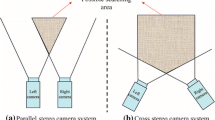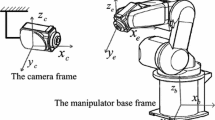Abstract
Visual servoing methods for hand–eye configuration are vulnerable for hand’s dynamical oscillation, since nonlinear dynamical effects of whole manipulator stand against the stable tracking ability (trackability). Our proposal to solve this problem is that the controller for visual servoing of the hand and the one for eye-vergence should be separated independently based on decoupling each other, where the trackability is verified by Lyapunov analysis. Then the effectiveness of the decoupled hand and eye-vergence visual servoing method is evaluated through simulations incorporated with actual dynamics of 7-DoF robot with additional 3-DoF for eye-vergence mechanism by amplitude and phase frequency analysis.









Similar content being viewed by others
References
Hutchinson S, Hager G, Corke P (1996) A tutorial on visual servo control. IEEE Trans Robotics Autom 12(5):651–670
Sepp W, Fuchs S, Hirzinger G (2006) Hierarchical featureless tracking for position-based 6-DoF visual servoing. In: Proceedings of the 2006 IEEE/RSJ International Conference on Intelligent Robotics and Systems (IROS), pp 4310–4315
Tahri O, Chaumette F (2005) Point-based and region-based image moments for visual servoing of planar objects. IEEE Trans Robotics 21(6):1116–1127
Malis E, Chaumentte F, Boudet S (1999) 2-1/2-D visual servoing. IEEE Trans Robotics Autom 15(2):238–250
Song W, Minami M, Mae Y, Aoyagi S (2007) On-line evolutionary head pose measurement by feedforward stereo model matching. In: Proceedings of IEEE International Conference Robotics Automation (ICRA), pp 4394–4400
Hamel T, Mahony R (2002) Visual servoing of an under-actuated dynamic rigid-body system: an Image-based approach. IEEE Trans Robotics Autom 18(2):187–198
Yoshikawa T “Foundations of Robotics: analysis and control”, ISBN 0-262-24028-9
Song W, Yu F, Minami M (2010) 3D visual servoing by feedforward evolutionary recognition. J Adv Mech Des Syst Manuf (JAMDSM) 4(4):739–755
Song W, Minami M, Aoyagi S (2007) On-line stable evolutionary recognition based on unit quaternion representation by motion-feedforward compensation. Int J Intell Comput Med Sci Image Process (IC-MED) 2(2):127–139
Minami M, Song W (2009) Hand-eye-motion invariant pose estimation with on-line 1-step GA -3D pose tracking accuracy evaluation in dynamic hand–eye oscillation. J Robotics Mechatron 21(6):709–719
Siciliano B, Villani L (2000) Robot Force Control, ISBN 0-7923-7733-8
Yu F, Song W, Minami M, Yanou A (2011) Frequency response of 3-D full-tracking visual servoing experiment with eye-vergence. In: Proceedings of IECON, pp 106–111
Author information
Authors and Affiliations
Corresponding author
Additional information
This work was presented in part at the 17th International Symposium on Artificial Life and Robotics, Oita, Japan, January 19–21, 2012.
About this article
Cite this article
Yu, F., Minami, M., Song, W. et al. Eye-vergence visual servoing enhancing Lyapunov-stable trackability. Artif Life Robotics 18, 27–35 (2013). https://doi.org/10.1007/s10015-013-0095-z
Received:
Accepted:
Published:
Issue Date:
DOI: https://doi.org/10.1007/s10015-013-0095-z




